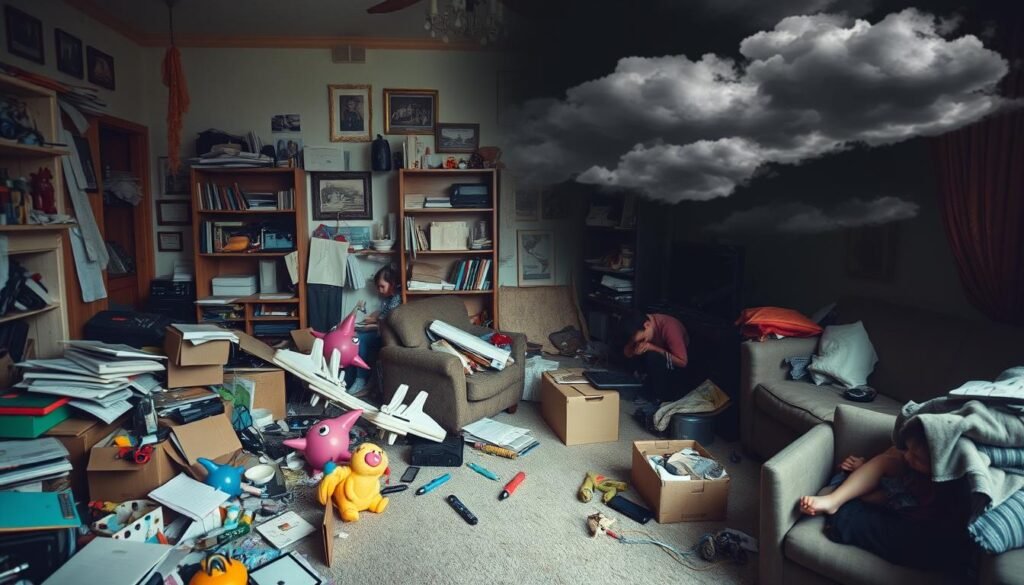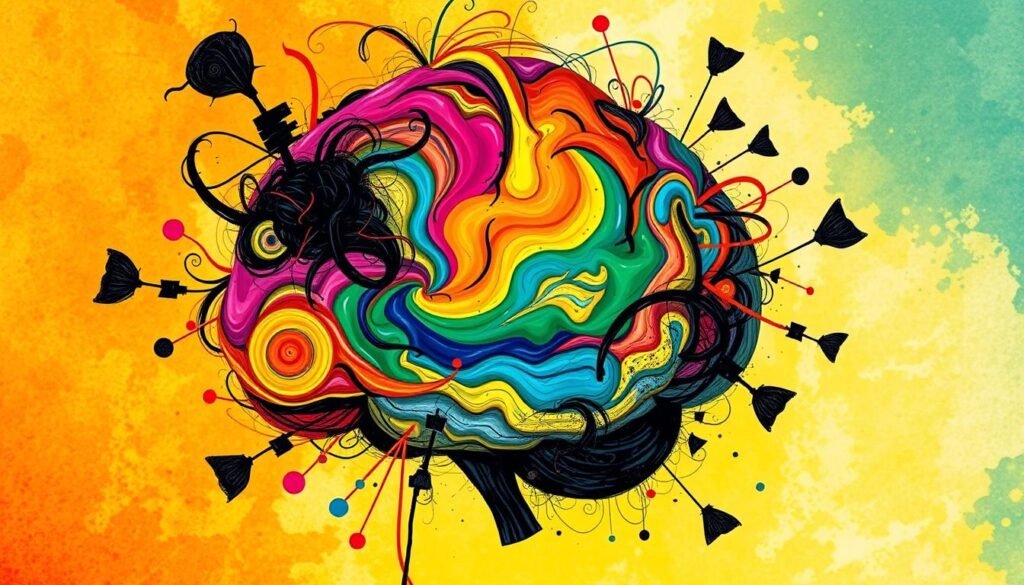Did you know up to 30% of kids with ADHD also face serious mood issues like depression? This fact shows how connected these two conditions are. ADHD affects focus and completing tasks. Depression brings on deep sadness that doesn’t go away easily. It’s important to understand how ADHD and depression are linked. This helps us see the challenges people with both conditions face.
Studies show over half of those with ADHD might seek help for depression at some point. They often experience hyperactivity, crankiness, and mood swings. These symptoms can make it hard to figure out the correct diagnosis. People with ADHD often have anxiety and depression more than others. This shows we need good treatments and ways to cope. Understanding their complex relationship helps us support affected individuals better. It leads to improved mental health overall.
Key Takeaways
- ADHD and depression frequently co-occur, with up to 30% of children diagnosed with ADHD also experiencing depression.
- Over half of individuals with ADHD may require treatment for depression during their lives.
- People with ADHD face a higher likelihood of being diagnosed with anxiety and depression compared to the general population.
- Anxiety often appears earlier in life for individuals with ADHD, whereas depression typically develops later in childhood.
- Effective treatment often involves a combination of medication and psychotherapy tailored to manage both conditions.
The Basics of ADHD
ADHD stands for Attention-Deficit/Hyperactivity Disorder. It is a brain condition seen mostly in children but can continue into adulthood. Learning about ADHD means looking into what it is, its signs, and its different forms.
Definition of ADHD
ADHD is known as a neurodevelopmental disorder. It impacts focus, impulsiveness, and activeness. These symptoms show up in early childhood. They affect daily life and school work.
This condition makes many everyday tasks tough. It can lead to trouble with thinking in different areas of life.
Symptoms and Characteristics
Some usual signs of ADHD are:
- Hard time paying attention
- Problems with keeping things organized
- Finding it tough to stay still
- Struggling with planning and finishing tasks
These symptoms can make school and friendships difficult. They lead to important troubles in how someone interacts with others.
Types of ADHD
There are three main kinds of ADHD:
- Inattentive Presentation: People find it hard to keep focused and miss out on details.
- Hyperactive-Impulsive Presentation: Individuals here may act hastily.
- Combined Presentation: This kind has symptoms of both attention issues and impulsiveness.
Knowing about these types helps in the right checking and help. Early ADHD detection means better help and managing extra problems, like depression. To learn about ADHD and depression, check out this detailed resource.
Understanding Depression
Depression is a complex condition that impacts many people, especially those dealing with mood-related issues like ADHD. It’s more than feeling sad. It involves a deep sense of hopelessness and a loss of interest in life. This can really affect someone’s mental health.
What is Depression?
Depression is a severe mood disorder. It changes how you feel, think, and handle daily activities. People with depression feel very empty or sad. They often lose interest in things they used to enjoy. This can start a cycle of negativity that gets worse over time.
Common Symptoms of Depression
Here are some symptoms people with depression might have:
- Prolonged sadness or irritability
- Chronic fatigue and low energy
- Difficulty in concentrating or making decisions
- Significant changes in appetite or sleep patterns
The severity of these symptoms can change. They can even lead to worse problems when paired with other mood disorders.
Impact on Daily Life
Depression deeply affects everyday life. It makes doing daily tasks, keeping relationships, and working much harder. People with depression often find it tough to work, stay close to others, and take care of themselves. This leads to a lower quality of life. It shows why understanding and treating depression is crucial.
The Overlap Between ADHD and Depression
Many people struggle with both ADHD and depression at the same time. It’s crucial to understand how these conditions overlap for proper treatment. A large number of people with ADHD also face depression. This makes careful assessment by doctors very important.
Comorbidity of ADHD and Depression
People with ADHD are more likely to feel depressed than others. Studies show about 17% of kids and teens with ADHD also have depression. This is way higher than the 4.4% in the general young population. In adults, the pattern is similar, with 18.6% of those with ADHD also dealing with depression. This is compared to 4.7% of all adults. What’s more, around 80% of people with ADHD have at least one other mental health issue.
Shared Symptoms and Challenges in Diagnosis
ADHD and depression have symptoms that are alike. Issues like trouble focusing, feeling irritable, and mood swings are common to both. This makes it hard for doctors to figure out the root cause of these symptoms. Without a careful look, it’s easy to misjudge the condition. Knowing the similarities helps in coming up with the right treatment plan.
| Population Group | With ADHD and Depression | With Depression Only |
|---|---|---|
| Children and Adolescents | 17% | 4.4% |
| Adults | 18.6% | 4.7% |
Why ADHD Increases the Risk of Depression
The link between ADHD and depression isn’t simple. Various factors make the risk of developing anxiety and self-esteem problems higher. It’s key to know these aspects to understand how ADHD can lead to depression.
Environmental Stressors
People with ADHD often face big environmental stressors. These can make depressive symptoms worse. Challenges like inconsistent care, trouble in school, and chaotic homes can lay the groundwork for anxiety.
As these issues keep happening, they might cause a cycle of frustration and hopelessness. This cycle can start or make depressive episodes more severe.
Social Challenges and Self-Esteem Issues
For those with ADHD, socializing can be hard. Being impulsive and not paying attention can get in the way of making friends. This struggle can cause self-esteem to drop as they often see themselves as less than their peers.
Feelings of worthlessness then grow, which is a perfect setting for depression. Studies show that women with ADHD, especially in their middle years, have a higher chance of being hospitalized for depression repeatedly.
Longitudinal Research Findings
Long-term studies give a clearer view of ADHD’s risks. Research shows that the risk of getting depressed is 6.5 times higher in the first year after being diagnosed with ADHD. Analyses say that shared genetic factors might cause about 70% of ADHD and depression cases happening together. That shows a biological connection.
The Avon Longitudinal Study of Parents and Children (ALSPAC) found strong links. It showed that ADHD symptoms might lead to depression starting earlier and happening more often over time.

| Factor | Effect on Depression |
|---|---|
| Environmental Stressors | Increase anxiety and depressive symptoms |
| Social Challenges | Contribute to low self-esteem and feelings of worthlessness |
| Longitudinal Findings | Show a significant 6.5-fold increase in depression risk after ADHD diagnosis |
| Genetic Factors | Account for approximately 70% of ADHD and depression co-occurrence |
ADHD and Depression: Understanding the Connection
It’s important to understand how ADHD and depression are linked to treat them effectively. Many studies have shown that these two conditions often occur together. This is especially true at various stages of life.
Statistical Evidence of Comorbidity
About 80% of adults with ADHD also deal with other mental health issues, like depression and anxiety. ADHD symptoms can make someone feel worse about themselves. This makes it hard for them to stay mentally healthy. For example, people with ADHD are much more likely to get depressed, with rates jumping to 22.1% from just 0.4%.
Age of Onset for Both Conditions
ADHD usually starts in childhood, often diagnosed between 4 and 7 years old. On the other hand, depression tends to show up during the teen years or early adulthood. Knowing this, it’s critical to catch ADHD signs early. This helps avoid depression later. It’s very important for girls, who often get overlooked, as they’re at a greater risk for later mood issues.
Understanding when ADHD and depression typically start can help provide better treatment. For more details on how they overlap, check out this link.
Identifying Overlapping Symptoms
It’s key to know the symptoms that ADHD and depression share. This is all-important for right diagnosis and help. Both can mess with how you think and feel, really affecting life. Knowing these signs helps tell the disorders apart, leading to better help.
Focus and Concentration Difficulties
People with ADHD find focusing hard, affecting school or work. Depression can do the same, making concentration tough. Understanding the differences in how these show up is vital. ADHD might make someone not pay attention, while depression can make someone not want to do anything.
Mood Disturbances and Emotional Regulation
Both ADHD and depression come with mood issues. ADHD can make someone’s mood change fast, maybe leading to fast acts. But, depression often brings deep sadness or no hope. These mood problems make handling emotions hard, but they show up in different ways. This info helps doctors figure out complex cases.

Treatment Options for ADHD and Depression
Managing ADHD and depression at the same time requires understanding both medication and therapy. The treatment plan depends on what each person needs and how they respond. Here are some ways to help those with both conditions.
Medication Approaches
Medications are key in treating ADHD and depression. Stimulants like Adderall help manage ADHD. Antidepressants, such as Bupropion, are good for those with both conditions. Selective Serotonin Reuptake Inhibitors (SSRIs), like Citalopram and Sertraline, treat depression. It’s important to watch for side effects and make sure the meds are working.
Therapeutic Interventions
Learning about and going through therapy are key parts of treatment. These methods help boost self-worth, regulate emotions, and teach coping methods. Cognitive Behavioral Therapy (CBT) is especially effective for tackling ADHD and depression. These strategies give people tools to understand their symptoms and improve their lives.
Combination Treatments and Strategies
Using both medication and therapy together often works best for ADHD and depression. This approach lets healthcare providers tailor the treatment for each person. Studies show combining these methods improves emotional well-being, coping abilities, and overall health.
| Treatment Type | Examples | Targeted Condition |
|---|---|---|
| Medication | Adderall, Bupropion, SSRIs (e.g., Sertraline) | ADHD, Depression |
| Therapy | Cognitive Behavioral Therapy, Psychoeducation | ADHD, Depression |
| Combination Treatments | Stimulants + CBT, SSRIs + Therapy | ADHD, Depression |
Managing ADHD and Depression in Daily Life
Living with ADHD and depression presents unique challenges. Effective self-care practices can lead to better mental health. It’s vital to manage symptoms with healthy routines and a strong support system.
Self-Care Practices
Daily self-care is key for ADHD and depression. Activities like walking or sports improve mental health. Eating well and getting enough sleep are also important. They keep your energy and mood steady.
Tracking your moods helps identify patterns and triggers. This makes it easier to handle symptoms. For more help, explore resources on boosting moods and well-being.
Building a Support System
Having a strong support system is crucial. Family and friends can help you feel less alone. Talking to therapists or joining support groups adds more support.
Knowing you’re not alone gives you strength and motivation. This encourages better self-care.

| Self-Care Strategies | Benefits |
|---|---|
| Regular Physical Activity | Improves mood and reduces anxiety symptoms |
| Nutritious Eating | Supports mental clarity and emotional stability |
| Proper Sleep Hygiene | Enhances focus and mood regulation |
| Mood Tracking | Identifies triggers and patterns for better management |
| Social Support | Provides emotional comfort and reduces feelings of loneliness |
Using these self-care practices and having strong support helps tackle daily challenges. It leads to better mental health for those with ADHD and depression.
Seeking Professional Help
Getting professional help is crucial for people struggling with ADHD and depression. Knowing when to see a doctor can greatly influence your path to better mental health. Early help means you can manage symptoms better and enjoy life more.
When to Consult a Doctor
If you have ongoing problems with ADHD or signs of depression, it’s time to seek expert advice. Facing constant disorganization, deep sadness, or trouble focusing are signs to get help. Recognizing these issues is the first step to getting better.
Importance of a Tailored Treatment Plan
Everyone’s experience with ADHD and depression is different. That’s why personalized care is key. A tailored treatment plan can address your specific needs. It combines medication, therapy, and lifestyle changes to work best for you. This approach treats symptoms more effectively and improves your mental health.
A personalized treatment plan can include:
| Component | Description |
|---|---|
| Medication | Medications can help, but they might need to be adjusted to work right and reduce side effects. |
| Therapy | Therapy, like cognitive-behavioral therapy, tackles root causes and helps you manage symptoms better. |
| Lifestyle Changes | Exercise, eating well, and sleeping right can boost your mood, focus, and overall health. |
| Support System | Having friends or family support you can make treatment more successful. |
Adding methods like yoga, mindfulness, and knowing your triggers can help control ADHD and depression even more. If you’re interested in self-care techniques, check out this resource for tips. Remember, asking for help is the first step to feeling better.
Conclusion
The link between ADHD and depression is crucial to understand. We need to know this to treat people effectively. About 44% of people with ADHD will have depression before they hit 30. This is much higher than the 25% of people without ADHD. Knowing the symptoms of both can help us improve people’s mental health and lives.
When we treat these conditions, we have to think about the big risks. For example, teens with ADHD and depression are more likely to think about suicide. Programs like BEAM and IPI-A are working well. They help reduce sadness and make it easier for people to control their emotions. This shows us how important it is to have care that fits the person’s needs.
We must keep researching and creating treatments that work best for each person. By focusing on ADHD and depression together, we can find better ways to help. This means people and their families will have a better chance at good mental health and happiness.